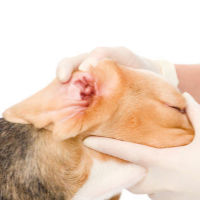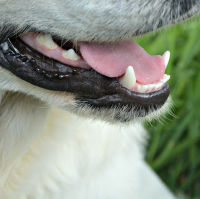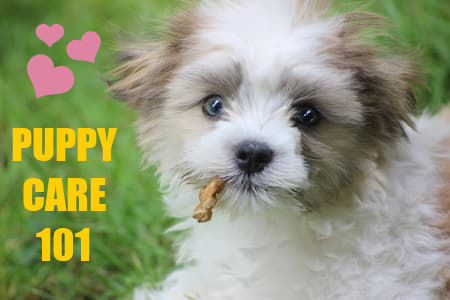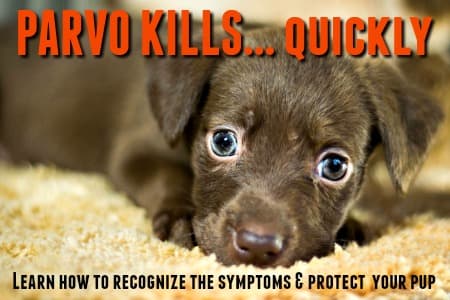FYI: If you buy something through a link on this site I may earn a commission - at NO extra cost to you.
Dog Eye Problems
Dog eye problems are fairly common, and can be caused by something as simple as getting grass or grit under the lid, or by something as serious as cancer.
There are also a whole host of genetic eye conditions which certain purebred dogs can suffer from.
These can cause minor problems or major ones.
To make matters even more confusing the symptoms of both minor and major dog eye issues can be very similar, at least at first.
In order to make sure that Fido's eyes are kept healthy it's important to know how to recognize problems, as well as what to do about them.
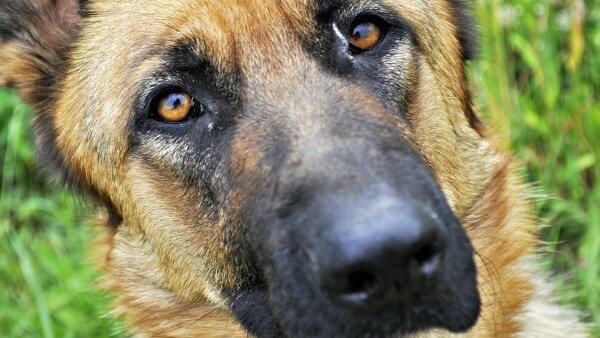
Types of Dog Eye Problems
There is a LOT of information about a whole host of dog eye problems on this page.
You can use these quick links to jump to the section which covers individual eye conditions:
- Corneal ulcers
- Keratoconjunctivitis Sicca (aka Dry Eye)
- Glaucoma
- Conjunctivitis (aka Pink Eye)
- Ectropion & Entropion (outer eyelid problems)
- Cherry Eye (inner eyelid problem)
- Retinal Atrophy
- Cataracts
- Injury or trauma to the eye
- Allergies
- Eye growths/cysts/tumors
- Pannus
Or you can use these links to jump to information on specific symptoms, and the eye problems they could indicate:
How To Administer Topical Eye Medications to Dogs
If your dog has eye problems, chances are good that you're going to need to put drops or other medication into his eyes.
Find out how to do this quickly, easily and without stressing him (or you) out right HERE.
Common Causes of Dog Eye Problems
Just as there are lots of different issues and conditions associated with your dog's eyes, there are a whole slew of things which can cause problems.
Sometimes a specific symptom can potentially be a sign of several different dog eye problems, or have more than one possible cause.
For example....
A very common symptom of trouble is a red or irritated eye, possibly with discharge or tearing.
This could easily be caused by any of the following...
- Allergies
- Injury
- Conjunctivitis
- Corneal ulcer
- Inner eyelid problem
In addition to infection, injury or inherent (genetic) issues, other causes of dog eye problems can include (but is not limited to) underlying health conditions such as:
- Diabetes
- Auto-immune diseases
- Liver problems
- Canine herpes
- Parasites (such as the skin mites who cause mange)
- Cushing's Disease
- Kidney Failure
- High Blood Pressure
- Dental abcesses (upper teeth)
Aging can also cause an increase in certain dog eye problems such as growths/warts/tumors in and around the eye, cataracts, and issues caused by underlying disease.
Dog eye problems which are congenital and hereditary are more common in some breeds than others.
These include:
- Primary Glaucoma
- Retinal Dysplasia
- Collie Eye (not entirely limited to Collie breeds)
- Primary Lens Luxation
- Central Progressive Retinal Atrophy
- Choroidal Hypoplasia
- Congenital Dry Eye
- Entropion & Ectropion
- Congenital Cataracts
Many purebred dogs are at risk of one, or more likely several, hereditary conditions.
For example, Progressive Retinal Atrophy has been found to be a problem for over 80 different breeds.
Primary Glaucoma can be found in Beagles, Basset Hounds, Cocker Spaniels, Samoyeds, Chow Chows, Poodles, Siberian Huskies and more.
Eye-lid problems affect many breeds with drooping eyes or loose facial skin.
These include Bulldogs, Chow Chows, Shar Pei, Great Danes, Bloodhounds and Mastiff breeds , among others.
Corneal conditions are most common in dog breeds who have naturally bulging eyes or flattened faces (brachycephalic), such as Bulldogs, Pugs and Shih Tzus.
Breeds with long coats are more prone to eye irritation and inflammation from the hair around their eyes.
These include Yorkshire Terriers, Olde English Sheepdogs, Maltese, Pekingese and similar breeds.
Some breeds are predisposed to more than one eye problem.
So, bottom line is - if your dog is experiencing problems with his eye, or eyes, there will be a variety of potential causes.
Given this fact, I'd like to emphasise this...
It is impossible to be sure of what is causing your dog's eye problems without getting a thorough evaluation by your vet.
Distinguishing between minor and major issues simply can't be done without seeing the underlying structures of the eye.
Even if your dog is simply squinting a little, or his eye is red or watering, please have your vet check him out to make sure that there's nothing seriously wrong.
Left untreated many dog eye problems can cause a lot of pain, vision loss (either temporary or permanent) and in some situations even loss of the eyeball itself.
Your own vet will often be able to diagnose and treat fairly minor dog eye problems, but will usually refer you to an veterinary opthamologist for more serious (even potentially serious) or complicated conditions.
Dog Eye Problems - Symptoms & Treatment
The symptoms of canine eye problems are often mild, at least to begin with.
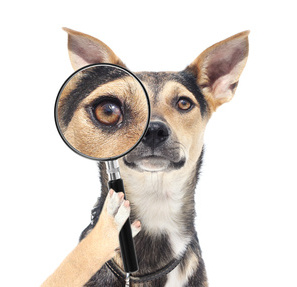
Barring an obvious injury or trauma of course.
Here is a list of some of the most common symptoms that you're likely to see if your dog is having issues with his eyes...
- Irritation - the whites may be reddened, eyes may water
- Excessive tearing
- Discharge - may be thin/clear, or thick/stringy mucus
- Squinting - in one or both eyes
- Bulging eye - the eyeball seems to be pushing out of it's socket
- Swelling - of the eyeball itself, the lids, or the surrounding tissue
- Cloudiness - an opaque appearance, may be localized/general
- Growths - these may be on the lids, surrounding tissue or eyeball
- Hair loss - around the outside of the eye area
- Scratching/Rubbing their eyes
Now we know what type of symptoms generally indicate dog eye problems, let's see which condition/disease each specific symptom may mean...
Dog Eye Irritation
Irritation, redness, and inflammation (swelling of the surrounding tissue) are the most common symptoms of dog eye problems - both minor and major.
Conjunctivitis
Also known as Pink Eye - this is one of the most common dog eye problems and the primary symptoms are red, irritated, inflamed eyes.
The area around the eyes may be swollen as well, and often there will be either a watery, or thick, discharge.
Conjunctivitis can be caused by a number of different things, including:
- Infection (both bacterial and viral)
- Foreign body (such as dirt or grit)
- Allergies
- As a result of having 'Dry Eye'
- Immune system problem or disease
- Growths, tumors or ulcers (on the eye or rim/lids)
- Injury
- Physical problem such as Entropion
Treatment options for Canine Conjunctivitis:
Your vet will do a full eye exam which may include staining the surface of the eye to look for damage or ulcers, test the pressure inside the eyeball to rule out Glaucoma and run cultures on any discharge that is present.
Eye drops and/or creams which contain antibiotics or anti-inflammatory medications are the most commonly prescribed treatment options.
Your dog may be prescribed more than one drop/salve once your vet had figured out what is at the root of the infection/inflammation.
A gentle eyewash such as Vetericyn Plus can help soothe irritation and irrigate the eye too.
A saline solution or a home-made mixture of 1/4 tsp salt dissolved in 1 cup of cooled, boiled water, is good for wiping away excess discharge or tears.
If your dog keeps rubbing, scratching or pawing at his eye/s due to the itchy discomfort, using an Elizabethan collar can help make sure he doesn't rub out the medication or cause more damage.
Canine Dry Eye (aka Keratoconjunctivitis Sicca)
Dry eye happens when your dog isn't able to produce enough tears to lubricate his eye/s.
This lack of lubrication can cause damage to the cornea because it becomes too dry, as well intense discomfort and irritation to the eye in general.
Dry Eye in dogs can be caused by:
- A congenital or physical problem with the tear producing mechanisms
- A virus (such as Distemper)
- Immune system disease
- As a result of Cherry Eye surgery
Certain breeds are at an above-average risk of suffering from Dry Eye.
These include Bulldogs, Spaniels, Yorkshire and West Highland Terriers and some breeds with prominent eyes such as Pugs, Boston Terriers, Pekingese and so on.
Just as Dry Eye can lead to conjunctivitis, it can also cause ulcers and scarring on the cornea.
Dry Eye is usually something your dog will have to live with for life, but when diagnosed before there is extensive damage to the eye, and with the proper treatment and management he will not have to be in discomfort/pain or lose his vision.
Early symptoms of Dry Eye in dogs include:
- Red, irritated eyes
- Chronic blinking
- Squinting
- Mucus discharge (often yellow)
If left untreated, chronic irritation of the surface of the eye can lead to damage such as ulcers and scarring.
More advanced symptoms include:
- Dull, dry appearance to the eyes
- A dark film across them
- Noticeable blood vessels on the front of the eye
Treatment options for Dry Eye (Keratoconjunctivitis Sicca):
There is a test called the 'Schirmer Tear Test' which your vet can use to figure out how much fluid your dog's eye/s produce.
He/she will also conduct a full examination of the eye and pay attention to previous history of injury, infection or eye problems.
Once a diagnosis of Canine Dry Eye has been made there is usually a three-pronged approach to treatment.
Your vet will most likely want to..
- Treat any infection, inflammation or damage to the eye
- Lubricate the surface of the eye to ease discomfort and reduce the chance of more damage
- Increase tear production for long term reduction of symptoms
Antibiotic ointment or drops may be prescribed, along with a medication to stimulate tear production.
Entropion in Dogs
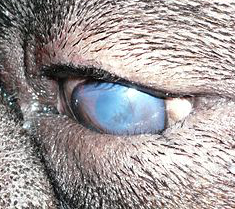 Photo credit to Joel Mills courtesy of Creative Common License
Photo credit to Joel Mills courtesy of Creative Common LicenseEntropion is one of the dog eye problems which can be caused by a physical malformation, in this case of the eyelid.
With Entropion, a dogs eyelids turn (or fold) inwards causing the eyelashes to rub against the eyeball and cause intense irritation.
The lower eyelid is more often affected than the upper one, but it is possible for either, or both, to be a problem.
If the rolling of the eyelid is slight, or only at the inner corner of the eye it may cause less problems.
Symptoms of Entropion include:
- Excessive tear production (watery eyes)
- Discharge
- Chronic squinting and/or blinking
- Visible malformation of the eyelids (turned inward)
It is another of those dog eye problems which is seen most often in certain breeds, due to the physical characteristics of their eyes.
There are a lot of breeds who are predisposed to suffer from Entropion include hounds such as the Basset Hound and Bloodhound.
Retrievers such as the Golden, Labrador, Chesapeake and Flat-Coated.
Large and extra-large breeds such as Mastiffs, Great Dane, Saint Bernard, Bernese Mountain Dog, Old English Sheepdog, Newfoundland etc.
Also Spaniels, Bulldogs, smaller Poodles, Staffordshire Bull Terrier, Yorkshire Terrier, Pekingese, Shih Tzu, Rottweiler and several more.
Because it can cause chronic infection, inflammation or scarring on the eye itself, Entropion needs to be diagnosed and treated as quickly as possible.
If left untreated for long periods, your dog could end up with scarring of the eye which could limit his vision.
On the bright side, Entropion is one of the dog eye problems which is fairly easy to recognize because the poor conformation of the eyelid is pretty easy to see.
Treatment options for Entropion in dogs:
Medication is not an option when it comes to treating this particular dog eye problem.
Because Entropion is caused by a malformation of the eyelid/s the only viable treatment to correct it is a surgery called 'Blepharoplasty'.
Fortunately, this is a common and relatively simple procedure with good end results. It's similar in nature to plastic surgery.
If Fido is a puppy or young dog (or the Entropion is severe) he may need two or more surgeries to allow for growth and to guard against over-correction.
The surgery will fix the conformational problem of the eyelid but won't fix any damage which it may have caused.
Your vet will make a full examination of your dog's eye, perhaps applying an anesthetic and staining the surface to check for scarring or ulcers.
Antibiotics, anti-inflammatory medications or other treatments are often used to heal secondary damage which is not permanent.
Ectropion in Dogs
Ectropion is a another of the dog eye problems which which affect the eyelid/lashes.
With Ectropion the eyelid rolls outwards (directly opposite to Entropion where the eyelid rolls inwards).
This causes the very delicate inner lining of the eylid/s and other membranes to dry out as they're exposed to the open air.
Dirt, dust, grit and other pollutants and foreign bodies can also irritate these sensitive areas.
In some cases a dog with Ectropion might not be able to fully close his eyes even when asleep.
All of this can cause dry eye and/or infection on top of the physical problem.
The symptoms of Ectropion can include:
Visibly deformed eyelid/s (roll outward)
- Excessive tearing, often resulting in staining of surrounding area
- Blinking
- Squinting
- Redness, irritation and/or inflammation
- Rubbing/pawing at eyes
- Eye discharge
Breeds with wrinkled faces or who have been bred to have 'droopy' eyes are more at risk of this conditions than others.
These include Basset Hound, Bloodhounds, Bull Mastiffs, Clumber Spaniel, Cocker Spaniel, Neopolitan Mastiffs, Newfoundlands, Saint Bernards, Bulldogs.. and more.
Treatment Options for Ectropion in dogs:
How your vet will choose to treat Ectropion depends on how severe the problem is.
For mild cases applying lubricating medications to keep the eye area moist is often enough to remedy the problem.
Of course, any infection/inflammation or damage which has already been caused needs to be treated as well.
Making sure to keep the whole eye area clean and wiping away tearing and discharge regularly can help stave off further infection.
Severe cases of canine Ectropion usually need surgery (a 'plastic surgery' type procedure) - either to the eyelid itself or to the facial skin.
Either way, the goal is to tighten up the eyelid and area below the eye, which should reposition the tear duct as well.
Pannus
Pannus (aka Chronic Superficial Keratitis) in dogs is an inflammatory condition which is linked to immune function.
Pannus affects the cornea, usually of both eyes, and at first can cause these symptoms:
- A slightly raised pink mass appears on the outer side of the cornea
- Thickened or irritated third eyelid
- Irritation, redness or tearing of the eye
As the condition progresses the mass thins out and spreads across the eye, giving the appearance of a gray/pink film covering the clear part your dog's eye.
The gray/pink color gradually darkens, possibly turning dark brown and opaque.
Redness, irritation, inflammation and tear production increase.
Veterinarians and scientists are not sure what causes Pannus but believe it's linked to abnormal immune function.
Allergen exposure, entropion, high exposure to ultra-violet light (sunlight) and being at high altitudes are believed to be contributing factors but don't necessarily cause Pannus.
Some breeds are more at risk of developing Pannus and these include German Shepherds, Border Collies and long-haired Dachshunds.
Treatment options for Pannus in dogs:
If your dog is diagnosed with Pano, your vet will most likely prescribe antibiotic drops or ointment for the eye and corticosteroids to reduce inflammation and any infection present.
Pannus is a life-long condition and not considered 'curable' (hence the word 'Chronic' in Chronic Keratitis) but it isusually very manageable with the right treatment and on-going vet care.
Corneal Ulcers (aka Ulcerative Keratitis)
Corneal ulcers (the Cornea is the clear part of the eye) happen as a result of other dog eye problems such as:
- Injury (eg. scratches or punctures)
- Dry Eye syndrome
- Entropion
- Infection
- Physical abnormality of eye (eg inability to fully close eyelids)
Corneal ulcers in dogs can be minor (superficial) or major (deep), or somewhere in between, depending on how many layers of corneal tissue is involved.
Shallow ulcers of the eye in dogs generally heal pretty well if treated quickly. But if they're left untreated they will get worse and cause more damage.
Deep ulcers are more difficult to treat, and take longer to heal. If severe enough they can even result in loss of vision.
Even very superficial ulcers can be extremely painful.
The symptoms of corneal ulcers in dogs can include:
- Excessive tearing
- Chronic squinting or blinking
- Over-sensitivity to light
- Redness, inflammation
- Discharge/pus
- Cloudiness or a film over the eye
- Swelling
Your vet will use a harmless dye which to diagnose an ulcer. This dye (or stain) will reveal the details and degree of damage and can also rule out other conditions which may mimic corneal ulcers.
Any breed of dog can suffer from corneal ulcers, especially those caused by trauma or injury.
However certain breeds are more likely to develop this problem for a variety of reasons.
These are generally the short-muzzled (brachycephalic) breeds, especially those who also have eyes which are slightly bulging by designe.
This includes English Bulldogs, French Bulldogs, Boston Terriers, Boxers, Maltese, Pekingese, Pugs and Shih Tzus.
Indolent Corneal Ulcers (aka Refractory Corneal Ulcers) is the term usually used to describe fairly superficial ulcers which fail to heal properly, or heal but recur.
These are most often seen in dogs who are at the canine equivalent of middle age, or older, and who are spayed/neutered.
Genetics (when the condition is hereditary) is believed to play a part, and dog breeds which seem predisposed to developing Indolent/Refractory corneal ulcers include the Samoyed, Dachshund, Boxer, Chihuahua, Shar Pei, Miniature Poodle, Shetland Sheepdog, West Highland Terriers, Cavalier King Charles Spaniel and Pembroke Welsh Corgi.
Treatment options for Corneal Ulcers in dogs:
How your veterinarian chooses to treat your dog's eye ulcer will depend on what caused it, and how severe it is.
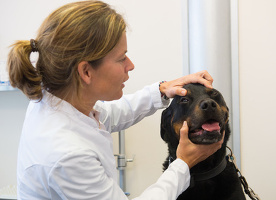
The overall aim of treating eye ulcers in dogs is to reduce your dog's pain, eradicate any infection which is present, minimize corneal scarring and encourage healthy tissue regrowth.
Superficial corneal ulcers are generally treated with topical drops or ointments (antibiotic and/or anti-fungal and for pain relief). Sometimes anti-inflammatory medications may also be given.
Deep ulcers often need all of this plus surgery to repair/replace the damaged cornea (or parts of it), followed by more topical medications.
Worst case scenario for really severe corneal ulcers in dogs which don't respond to medication, or surgical repair, is the removal of the eyeball itself.
This sounds extreme, and is a last resort, but dogs generally bounce back from this pretty quickly and seem much less phased by the whole thing than their owners do.
A recent addition to the veterinarian's treatment arsenal for corneal ulcers and some other serious eye injury or conditions is a new, high-tech 'bio-bandage'.
When applied to the eye by your veterinarian (in a similar way to a contact lens) the bio-bandage can help promote healing which would otherwise be impossible.
This is great news for veterinarians, dogs and their owners... and in the future will hopefully save the sight of many dogs.
Dog Eye Allergies
Dogs can suffer from allergies just the way we humans do.
These could be triggered by food, medications, something your dog comes in contact with, or airborne/seasonal allergens.
Windy weather, hanging their heads out of the car window, or simple seasonal triggers can all make Fido's eyes sore, itchy and irritated.
Some dogs breeds tend to suffer from allergies more often than other breeds, but a dog of any breed can have this type of problem.
If dust, grass, grit or dirt gets stuck under the eyelid it can cause inflammation and eventually infection.
Although irritated eyes are one symptom of canine allergies, skin irritation and ear problems are more common.
Treatment options for Dog Eye Allergies:
As with any type of allergy, the best cure is to find out what's triggering symptoms and remove it.
This isn't as easy to do as it sounds, but you can often be successful if you play detective.
Pay attention to when Fido's eyes become irritated and work backward to see what he has eaten/come in contact with/been doing can help. Keep a notebook if it helps.
Eye allergy symptoms in dogs such as redness, itching or inflammation are generally due to airborne or seasonal allergies, or to something which has come in direct contact with his eyes.
Food allergies or flea allergies are more likely to cause skin irritation, or ear problems. BUT they can also be to blame for itchy, irritated eyes at times.
A gentle eye rinse such as Vetericyn Plus can soothe itchy eyes and remove dust, pollen and debris.
Your vet may want to prescribe or recommend antihistamines in some form, and these are usually very effective.
If the allergy has caused an infection to set in, or constant rubbing or scratching has caused damage to the surface of the eye, your vet will most likely also prescribe antibiotics or anti-inflammatories.
Dog Eye Injury or Trauma
A fairly common cause of dog eye problems is injury.
The injury itself can be major and obvious, or be minor and hard to pinpoint.
Dust, grit or debris in the eye can cause irritation, inflammation, infection and even damage to the surface of the eye, the cornea, or inner eyelid.
If your dog gets into a tussle with the cat, or another dog, his eye can be damaged by sharp claws or teeth.
Early symptoms of squinting, tearing or irritation can turn into abrasions, ulcers and/or damage to the cornea.
Treatment options for Dog Eye Injuries or Trauma:
Treatment will depend on what type of injury your dog's eye has sustained.
Scratches, ulcers or penetrating wounds each require a different approach.
Your vet will evaluate the damage and start treatment.
For minor injuries medications may be all that's required, for more serious damage surgery may be an option.
Dog Eye Swelling
There are several different parts of your dog's eye which can become swollen.
Some dog eye problems cause the inner eyelid to swell or become inflamed. Some may cause swelling in the tissue around the eye.
Others cause the actual eyeball to swell, causing it to bulge forward in the socket.
Here are the most common causes of swelling in, or around, a dog's eye.
Cherry Eye
This is an eye problem in dogs which is reasonably common and happens when the tear gland attached to the inner eyelid prolapses (basically means 'fallen down' or 'slipped').
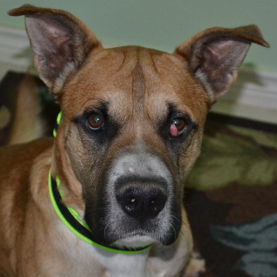 Cherry Eye (this is my dog, Ivan) before corrective surgery
Cherry Eye (this is my dog, Ivan) before corrective surgeryThis is exactly what happens because the gland falls, or slips, out of place causing a red, swollen mass to bulge over the rim of the eyelid.
Cherry Eye is is pretty easy to recognize.
The swelling may be small, the size of a pea, or it could be much larger and cover a good portion of the eye itself.
The veterinary community doesn't have a specific answer as to what causes Cherry Eye, but a loosening or weakening of the connective tissue is a factor and some breeds are more prone to it than others so there is likely a genetic component as well.
Although it looks very painful it doesn't always seem to be, but it is definitely uncomfortable and if your dog rubs or scratches at it he can cause more serious damage to his eye.
If the enlarged gland becomes irritated or inflamed, or there's pus or discharge, then infection is possible. Dryness can also cause discomfort.
Some breeds which are prone to suffering from this condition include the Beagle, Bloodhound, Boston Terrier, Bull Terrier, Saint Bernard and Shar Pei.
Treatment options for Cherry Eye in dogs:
The most common treatment for this condition is one of two surgeries.
The first surgical option is for your vet to 'tack' the gland back into place.
This is the least invasive procedure and is most successful with small swellings.
But it's also fairly common for this tacking to fail after a period of time, resulting in the swollen gland reappearing and the need for another surgery.
The second surgical option is to remove the affected gland altogether.
This is obviously a much more permanent solution.
Once removed the tear gland cannot reappear so there is no need for additional surgeries. There is a risk of dry eye due to decreased tear production, either in the short term or long term.
My last rescue dog, Ivan, had this surgery shortly after we brought him home and sailed through it with absolutely no negative after-effects at all.
You can read my dog's story here... Cherry Eye in Dogs - Ivan's Story
Sometimes, rather than going the surgical route first, you vet may suggest trying anti-inflammatory eye drops or other medications.
This combined with massage may allow the gland to slide back into the correct position.
Glaucoma
Glaucoma is the name for a condition which causes the actual eyeball to swell.
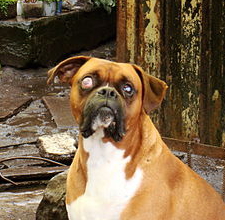 Photo credit Flickr via Creative Commons License
Photo credit Flickr via Creative Commons License'Primary' Glaucoma is caused when the physical shape of a dog's eye makes it impossible for the fluid content of the eye to maintain the correct balance.
Fluid then builds up inside the eyeball itself causing intense pressure which damages the eye itself.
The breeds at a higher risk of developing Primary Glaucoma include Beagles, Bassset Hounds, Cocker Spaniels, Norwegian Elk Hounds, Dachshunds, Chihuahuas, Shar Peis, Giant Schnauzers, Bouviers de Flandres, many Terrier breeds and also Northern breeds such as Chows and Huskies.
'Secondary Glaucoma' happens as a result of another disease or condition.
These could include an injury or trauma to the eye, inflammation (including Uevitis), a problem with the lens of the eye, a chronic condition such as Diabetes... basically anything which might cause fluid buildup within the eyeball.
Glaucoma in dogs can become very serious, very quickly so it's vital to be aware of the early symptoms and seek veterinary help IMMEDIATELY!
Some symptoms of Canine Glaucoma to watch for include:
- A cloudiness to the eye
- Dilated pupil
- Increased blood vessels in the white part of the eye
- Pain/discomfort (pawing, rubbing or scratching at the eye)
- Bulging of the affected eye (pushing forward or sideways)
Treatment options for Canine Glaucoma:
Because Glaucoma results from elevated pressure within the eyeball, your vet will use a Tanometer to evaluate this.
The normal range for this is 15 - 25 mm Hg (mm's of mercury). A pressure of 30 mm HG or higher indicates Glaucoma. Anything over 40 mm Hg can damage the optic nerve and retina and cause blindness.
Any injuries, illnesses or other eye problems also need to be considered so that he/she can determine the cause of the problem and whether the Glaucoma is primary or secondary.
Glaucoma is not as easy to treat and control in dogs as it is in humans.
What treatment is given for Glaucoma in dogs depends on how severe the condition has become, what is causing it, and how much damage has been done...
- Medications to reduce pressure within the eye (topical or ingested)
- Draining of fluid from the eyeball
- Cyclocryotherapy (inhibits the production of intra-ocular fluid)
- Gonioimplantation (placing shunts to drain fluid)
If none of these options are effective, or the damage is too great, there are two other surgical options...
- The internal contents of the eye are taken out and replaced with a synthetic orb.
- The entire eyeball is removed and either replaced with a prosthetic eyeball, or the empty socket is simply stitched closed
Although these last two sound scary, removing the eyeball is relatively straightforward and the result isn't nearly as awful as you may imagine.
It eliminates the pain and danger that Fido is in and he will manage just fine with one eye.
Glaucoma is painful, sometimes intensely so, for your dog and pain medications will also be a part of his treatment.
If Glaucoma is the result of an underlying illness, injury or infection, that obviously also needs to be treated and controlled.
Dog Eye Discharge
Discharge from your dog's eye/s can be thin, watery, clear, stringy, thick, yellow or green.
The type of discharge is often a clue as to what is causing the issue, but several dog eye problems can cause similar discharge.
Thick mucus which is tinged with green or yellow usually indicates infection of some sort, but of course you can't be sure what is causing the infection without a vet evaluation.
Here are a few of the most common reasons for dog eye discharge, all of which are covered on this page:
- Conjunctivitis or Infection
- Dry Eye
- Cherry Eye
- Glaucoma
- Entropion
- Allergies
- Physical problem with tear duct/s
- Corneal Ulcer
- Lens displacement
- Injury or damage to the eye
- Underlying Disease - localized or systemic
Click on above links for full information on symptoms & treatment options
Cloudy or Opaque Eyes in Dogs
If your dog's naturally clear, bright eyes become cloudy, smoky, dull or opaque then you need to have him seen by a veterinarian.
Most often the cloudiness is visible in the colored part of the eye (retina) or pupil.
Depending on the cause of the problem your dogs vision is likely to be affected to differing degrees.
Sometimes the white part of the eye may look dull or opaque, this is generally due to an underlying disease elsewhere in the body and usually doesn't affect his sight.
The four conditions which are most likely to cause cloudy or opaque eyes in dogs are Glaucoma, Cataracts, Uveitis, Pannus, and injury or damage to the eye.
Ulcers and Dry Eye can sometimes lead to cloudiness in the eye as well.
As your dog ages it's normal for his eyes to look vaguely cloudy or smoky, with a blue or blue/gray tint. This is called Nuclear Sclerosis and is a natural part of getting older.
It usually doesn't limit Fido's vision to a great degree and your vet is unlikely to recommend treatment.
Let's take a look at the three most likely culprits here...
Canine Glaucoma
Cloudiness in the eye/eyes is just one symptom of Glaucoma.
I've covered this condition more fully above, under the section entitled 'Dog Eye Swelling'. Click here to jump straight there.
Cataracts in Dogs
Cataracts happen when the lens of your dog's eye becomes cloudy or opaque.
They can develop as your dog ages, occur in puppies as young as 6 months old (when it's a hereditary problem), or appear at anytime in between.
The degree of cloudiness is what limits Fido's vision. Imagine looking through a pane of clear glass, then through panes which have been frosted to various degrees... you get the picture.
Cataracts can appear in one eye, or both.
The lens may cloud over in a uniform way, or it could start out with small, opaque areas or strips.
Once cataracts start to form they will continue to spread and get worse, until eventually sight is lost.
How quickly this happens depends on why they're forming in the first place.
It is impossible for you to know what the cloudiness of your dog's eye means, so a vet visit is essential.
Some of the causes of Canine cataracts include:
- Trauma or injury to the eye
- Old age
- Underlying health conditions such as Diabetes
- Inflammation (Uveitis)
- Genetics (some dog breeds are predisposed to developing cataracts)
Breeds which have an above-average risk of developing cataracts include Bichon Frise, Boston Terriers, Cocker Spaniels, Havanese, Labrador Retrievers and Golden Retrievers, Poodles, Miniature Schnauzers, Siberian Huskies and Smooth Fox Terriers.
Treatment options for Cataracts in dogs:
You won't be able to tell the difference between cataracts and general cloudiness of the eye (as a result of other conditions) with the naked eye.
Even your vet will need to use specific instruments to determine whether your dog does have cataracts, and how much damage has been done to the retina.
An opthalmoscope will let your vet get a good look at the eye, and if the problem is a cataract, an electroretinogram will show him how damaged, or deteriorated, the retina is.
The only effective treatment for canine cataracts is surgery to remove the damaged lens... and this is only worthwhile if the retina is still healthy.
It's a fairly straightforward procedure, and usually the extracted lens is replaced by an artificial one, although this isn't strictly necessary.
If Fido's retina has been too badly damaged then removing the cataracts won't restore his sight. In this situation your vet would determine whether it would reduce pain or be helpful to undertake the surgery.
Progressive Retinal Atrophy
Progressive Retinal Atrophy is also known as Progressive Retinal Degeneration (often shortened to PRA or PRD).
This eye condition affects the retina - a layer of light-sensitive tissue which lines the inside of your dog's eyeballs.
The fact that it is labeled 'Progressive' means that the condition is a chronic one which worsens over time.
The word 'Atrophy' describes the nature of the condition, which is a gradual decline in the function and effectiveness of the retina.
It's also one of the genetic, or inherited, dog eye problems.
Breeds most at risk of PRD include Akitas, Border Collies, Briards, Bull Mastiffs, Cocker Spaniels, Golden Retrievers, Irish Setters, Labrador Retrievers, Miniature and Toy Poodles, Samoyeds, Siberian Huskies, Shetland Sheepdogs, Tibetan Terriers and many more.
The age at which dogs are affected by retinal atrophy depends on the exact nature of their condition.
Retinal Dysplasia is more common in certain breeds and this starts in puppy-hood, as early as 8 - 10 weeks of age.
Retinal Degeneration can be considered 'early onset' when it shows up in puppies and young dogs aged between three months and two years.
Or it can be considered 'late onset' when it affects adult dogs between four and eight years old.
Sudden Acquired Retinal Degeneration can happen in middle aged to senior dogs, more commonly in females, and this causes sudden blindness.
The symptoms of Progressive Retinal Atrophy can be vague at first because the degeneration of the retina causes a slow loss of vision.
The things which might give you a hint of the problem include:
Gradual loss of night vision. This is often the first symptom. Your dog may seem to see fine during daylight hours, but starts bumping into things or be hesitant when waking around at night. He may also have trouble seeing in extremely bright light. This eventually happens in normal daylight as well, as the blindness progresses.
Dilated pupils. They may become dilated, or react to light in an abnormal way.
Cloudiness or opaque eyes. If the lens of the eye is affected it may become cloudy or look milky. Cataracts can form as the disease progresses.
Tests for PRA can be done by your vet and they're painless for your dog.
Treatment options for Progressive Retinal Atrophy in dogs:
Unfortunately PRA has no cure and will lead to blindness over time.
The plus side of this is that most dogs manage just fine even once their sight has dimmed completely.
Obviously keeping them in a familiar environment helps as they learn to adjust and adapt.
This is not a painful condition.
Some dogs don't completely lose their sight and retain some peripheral vision.
Dog Eye Growths, Cysts and Tumors
There are several different dog eye problems which involve growths of one sort or another.
These growths can be on the eyelid or on different parts of the structure of your dog's eye.
Some are innocuous and non-threatening, others can be malignant and potentially dangerous... and it's not necessarily easy to tell the difference.
If you notice any kind of a growth, cyst or lump on your dog's eye or eyelid it's always best to have it checked out with your vet to get an accurate diagnosis.
Stye
A Stye is a pus-filled abscess and usually shows up as a small (or not so small) lump on the inner eyelid, either upper or lower.
If your dog has a stye, the swollen area will likely be red and his eye will probably be irritated or watering.
Generally a stye will heal on its own within about a week.
Keeping the area around the stye clean is important, so wash that area with clean warm water daily.
Treatment Options for a Stye on your dogs eye:
Heat can help a stye 'come to a head' and then drain. If your dog will allow you to hold a warm moist cloth over the eye several times a day that can speed up healing.
Correct diagnosis of dog eye problems is really important, so I would strongly recommend having a vet take a look at your dog's eye when the lump/irritation first appears.... just to confirm that it IS a stye.
After that home treatment is generally enough. Unless your vet prescribes medication or any other procedures.
However, if the stye doesn't seem to get better over a period of a few days, or if it gets worse/bigger/your dog seems in pain or the eye looks more irritated it's important to take him back to your vet.
Sometimes infection increases and an antibiotic ointment or eye-wash, corticosteroids or an oral antibiotic is needed.
With severe styes which don't respond to medication, surgical draining and removal can take place to put an end to the problem/infection.
Chalazion or Meibomian Cyst
A Chalazion (sometimes called a Meibomian Cyst) looks similar to a Stye and is caused by inflammation/blockage of the oil glands on the rim of the eyelids.
A Chalazion appears as a swollen, reddened area on the upper or lower eyelid, close to the eyelashes.
Your dog's eye may also be irritated, or watery. He may blink or squint.
Because this could be a Stye, or a Chalazion, or another dog eye problem it's important to take your dog to the vet for an exam if he has this type of swelling.
Treatment Options for a Chalazion on your dog's eye:
Many times the Chalazion will heal and disappear on it's own.
As with a Stye, keeping the area clean and applying warm compresses several times a day can speed healing.
However if the swelling continues to grow or doesn't start to heal within a few days, there is pus/blood, the eye becomes more red/irritated/watery or your dog seems to be in pain, then it's very important to have your veterinarian re-examine it as further treatment is needed.
A Chalazion/Meibomian cyst can be surgically removed by your veterinarian.
Occasionally a Meibomian cyst can be cancerous, this is more common in older dogs and in certain breeds.
Breeds at an above-average risk of this include Nordic breeds such as the Samoyed, Siberian Husky an Alaskan Malamute as well as Labrador Retrievers, the standard Poodle, Shih Tzu's and the West Highland White Terrier.
Sebaceous Cyst
There are several types of Sebaceous Cysts and they can occur on any part of your dog's body, including the eyelids.
They are basically a sac like growth which contains sebum (a natural oily lubricant).
These grow as they fill up with fluid, sometimes they rupture and heal by themselves, other times the can become infected.
As with all growths around your dog's eyes (or anywhere else on his body for that matter) it's important to have your vet check it out to determine what type of cyst/growth it is.
Treatment options for Sebaceous Cysts:
Sebaceous cysts that are not causing your dog pain or discomfort and that have not become infected can often just be left alone.
But if it's too large, causing pain/discomfort, or becomes infected then your vet will need to either drain or remove it.
Do NOT try to 'pop' or drain this type of cyst yourself as you are likely to cause infection or make the situation worse.
Tumors
Dog eye problems can include a number of tumors, some benign others cancerous.
It is impossible for us as dog owners to tell the difference and if your dog has a growth on his eyelid, eye or surrounding tissue it's vital to have your vet examine it so that you can get an accurate diagnosis.
The most common types of eyelid tumor in dogs include:
- Meibomian Adenocarcinoma
- Squamous Cell Carcinoma
- Basal Cell Carcinoma
- Melanoma
- Histiocytoma
- Mastocytoma
- Papilloma
It's more likely that a growth or lump on your dog's eyelid is benign than it is cancerous, but it is never a good idea to 'wait-and-see'... unless your veterinarian tells you otherwise.
Regardless of the type of tumor, early diagnosis and surgical removal of the growth gives your dog the best chance of making a full recovery.
How To Apply Dog Eye Drops or Liquid
Drops, creams or other topical medications are one of the recommended treatments (or the only recommended treatment) for many of the dog eye problems on this page.
Putting medication into/onto your dog's eyes can be pretty simple - IF you know how to do it.
Even if Fido is the most laid-back pooch every, having goopy stuff forced into his eye probably isn't high on his list of acceptable human practices!
This short video will help you get that important medication where it needs to be with the minimum of fuss....
CLICK HERE to read an article about eye problems in dogs, written exclusively for this website by veterinarian Dr. Megan Teiber, DVM
For your peace of mind, puppy and dog health information on this site has been approved by veterinarian Dr. Megan Teiber, DVM
you might also like...
- Home
- Dog Health Information
- Dog Eye Problems
FTC Disclosure: Some pages on this site contain affiliate links. I may earn on qualified purchases.
